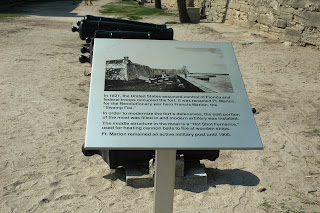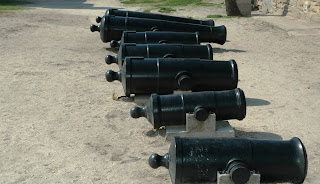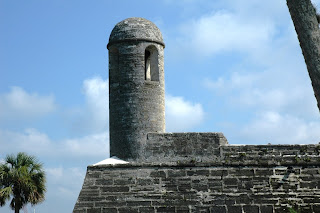Castillo de San Marcos
St. Augustine, FL
The Castillo de San Marcos is unique in North American architecture. As the only extant 17th century military construction in the country and the oldest masonry fortress in the United States it is a prime example of the "bastion system" of fortification, the culmination of hundreds of years of military defense engineering.St. Augustine, FL

It is also unique for the material used in its construction. The Castillo is one of only two fortifications in the world built out of a semi-rare form of limestone called coquina (The other is Fort Matanzas National Monument 14 miles south)

Given its light and porous nature, coquina would seem to be a poor choice of building material for a fort. However the Spanish had few other options; it was the only stone available on the northeast coast of La Florida. However, coquina's porosity turned out to have an unexpected benefit. Because of its conglomerate mixture coquina contains millions of microscopic air pockets making it compressible.

A cannon ball fired at more solid material, such as granite or brick would shatter the wall into flying shards, but cannon balls fired at the walls of the Castillo burrowed their way into the rock and stuck there, much like a bb would if fired into Styrofoam. So the thick coquina walls absorbed or deflected projectiles rather than yielding to them, providing a surprisingly long-lived fortress.

After the British established colonies in Georgia and the Carolinas, Spain authorized the building of a stone fort to protect St. Augustine as assaults from the north became more frequent. The Castillo de San Marcos took twenty-three years to build but, once in place, stood as the town's stalwart defender. Major attacks were made against her in 1702 by Governor James Moore of South Carolina and in 1740 by General James Oglethorpe of Georgia. Neither seige was successful, however, and to this day, the fort has never fallen to enemy attack.

It was not until 1763 that Spain ceded Florida to England in order to regain the capital of Cuba, ushering in twenty years of British rule in Florida. This period coincided with the American Revolution, during which Florida remained loyal to the Crown. In 1783, under the Treaty of Paris, Florida was returned to Spanish rule for a period of thirty-seven years. The Spanish departed for the last time when Spain sold Florida to the United States of America. At a colorful military ceremony on July 10, 1821, US troops took possession of the territory and Spain relinquished control of Florida forever.




In 1845, Florida became the twenty-seventh state admitted to the Union. The Castillo de San Marcos was renamed Fort Marion in honor of a Revolutionary War hero, and the capital of East Florida was moved from St. Augustine to become part of the state capital in the new town of Tallahassee.




The town had finally begun to prosper when the American Civil War broke out in 1861. Although Florida had seceded with the rest of the Confederacy, St. Augustine was occupied by Union troops throughout most of the conflict. When the war ended in 1865, the town was three centuries old. The war's end brought speculators and land developers to Florida along with the beginnings of the visitor industry.














No comments:
Post a Comment